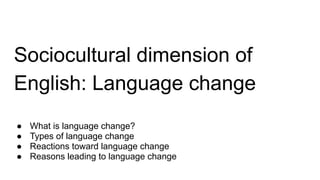
Language Change.pdf
- 1. Sociocultural dimension of English: Language change ● What is language change? ● Types of language change ● Reactions toward language change ● Reasons leading to language change
- 2. Development of English Language
- 3. What is language change? ● The modification of forms of language over a period of time and/or physical distance. ● May affect any parts of a language (pronunciation, orthography, grammar, vocabulary) and is taking place all the time. Source: Oxford Companion to the English Language.
- 4. Shakespeare ● Introduced hundreds of new words, many of which are still used today. ● He created words by "changing nouns into verbs, changing verbs into adjectives, connecting words never before used together, adding prefixes and suffixes, and devising words wholly original." ● Some examples of the words he invented are: accused, addiction, advertising, assassination, bedroom, bloodstained, fashionable, gossip, hint, impede, invulnerable, mimic, monumental, negotiate, rant, secure, submerge, and swagger.
- 5. Types of language change Phonetic change a. Occurs when the pronunciation of certain sounds in a language changes over time. b. Happens due to language contact, cultural influences, and changes in speech patterns. E.g: The Great Vowel Shift in English (14th and 17th centuries) - the vowel sound in words like "name" and "day" used to be pronounced like the vowel in the word "ah" but over time it shifted to sound more like the vowel in the word "ee" Lexical change a. Refers to changes in the vocabulary of a language over time. b. Happens due to borrowing from other languages, the creation of new words, and the loss of older words that are no longer in common use. E.g: The English language has borrowed many words from French, such as "restaurant," "fiancé," and "champagne."
- 6. Types of language change (Cont) Semantic change a. Occurs when the meaning of a word changes over time. b. Happens due to cultural shifts, changes in technology or scientific knowledge, and shifts in social norms and values. E.g: The word "gay," which originally meant "happy" or "carefree," but has shifted over time to primarily mean "homosexual." Syntactic change a. Refers to changes in the way that sentences are structured in a language. b. Happens due to changes in the way that people use language in everyday communication, as well as changes in grammatical rules and conventions. E.g: In Old English, nouns had different forms depending on their grammatical role in a sentence (such as "man" vs. "men"), now nouns are typically distinguished only by their position in a sentence.
- 7. How do people react to language change when they notice it? ● Often negative - the language has "gone downhill". ● Conscious attempts to resist change ● Deliberate attempts made by social pressure groups/governments to change aspects of a language or its use.
- 8. How and why does language change? 1) Language learning 2) Language contact 3) Social differentiation 4) Natural processes in usage
- 9. 1) Language learning ● The experience of each individual is different, and the process of linguistic replication is imperfect, so that the result is variable across individuals. ● Regularization --will cause systematic drift, generation by generation. ● Random differences may spread and become 'fixed', especially in small populations.
- 10. 2) Language contact ● Migration, conquest and trade bring speakers of one language into contact with speakers of another language. ● Norman French conquered England (1066) and used their own language for business of occupying power strong French influence on English legal terms: justice, jury, goal despite the existence of Old English forms.
- 11. 2) Language contact (Cont) Tok Pisin: Late 19c from Eng. Talk Pidgin https://www.youtube.com/watch?v=AjHoFL8pECQ ● English-based lingua franca of Papua New Guinea-descended from varieties of Pacific Jargon English during 19c used between English-speaking Europeans and Pacific Islanders, e.g. John’s houseHausbilongJohn ● Children started speaking TP as their L1 for all their needs and so it becomes a creole.
- 12. 3) Social differentiation ● Social groups adopt distinctive norms of dress, adornment, gesture and so forth; language is part of the package. ● Linguistic distinctiveness can be achieved through vocabulary (slang or jargon), pronunciation (usually via exaggeration of some variants already available in the environment), morphological processes, syntactic constructions, and so on.
- 13. 4) Natural processes in usage ● Rapid or casual speech naturally produces processes such as assimilation, dissimilation ● Word meaning change in a similar way, through conventionalization of processes like metaphor and metonymy.
- 14. All living languages change. They have to. Languages have no existence apart from the people who use them. And because people are changing all the time, their language changes too, to keep up with them. The only languages that don't change are dead ones. Even so, it's possible to bring a language back from the grave and make it live – and change – again. David Crystal